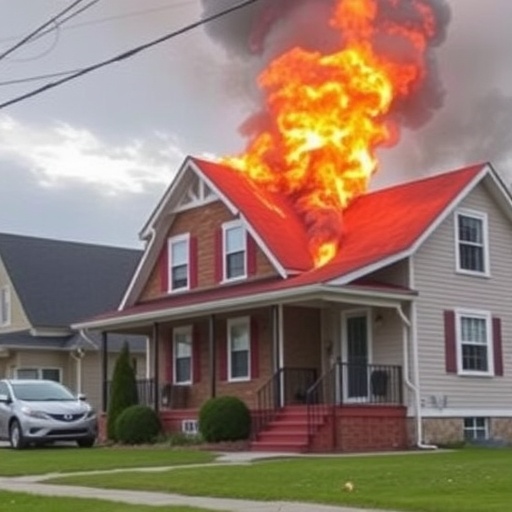U.S. Foreclosures Surge 25% in 2024: Politicians Ignore Housing Crisis as Midterm Elections Loom
In a stark reminder of the fragility of the American Dream, Foreclosures across the United States have skyrocketed by 25% in the first half of 2024, displacing thousands of families while politicians in Washington remain conspicuously silent on the escalating housing crisis. This surge, driven by soaring interest rates and stagnant wages, is not just a financial footnote—it’s a ticking time bomb that experts say could upend the economy and reshape U.S. politics heading into the 2026 midterm elections.
- Foreclosure Filings Hit Decade-High in Sun Belt States
- Families Devastated: Heartbreaking Tales from the Frontlines of Eviction
- Washington’s Blind Spot: Why Politicians Are Sidestepping the Housing Crisis
- Economic Fallout Looms: Foreclosures Threaten Broader Market Stability
- Midterm Elections 2026: Housing Crisis as the Ultimate Voter Wildcard
The numbers are alarming: According to data from ATTOM, a leading provider of real estate analytics, foreclosure filings reached 93,000 in the second quarter alone, the highest quarterly figure since 2010. States like Florida, Texas, and Illinois are bearing the brunt, with urban centers seeing the sharpest increases. For families like the Garcias in Miami, who lost their home after medical bills piled up, this isn’t abstract policy—it’s a personal catastrophe. “We worked our whole lives for that house,” Maria Garcia told reporters, her voice breaking. “Now we’re couch-surfing with relatives, and no one in Congress seems to care.”
This oversight from lawmakers isn’t accidental; it’s a symptom of deeper divisions in U.S. politics. As inflation cools and stock markets hit records, the housing crisis has fallen off the national radar, overshadowed by flashier issues like tech innovation and foreign policy. But with homeownership rates dipping below 65% for the first time in decades, according to the U.S. Census Bureau, the human cost is mounting. Experts warn that without intervention, Foreclosures could trigger a broader economic downturn, echoing the 2008 meltdown but with a modern twist: millennial and Gen Z buyers locked out by unaffordable prices.
Foreclosure Filings Hit Decade-High in Sun Belt States
The epicenter of this foreclosure wave is the Sun Belt, where rapid population growth has outpaced housing supply, leaving residents vulnerable to economic shocks. In Florida, filings jumped 42% year-over-year, fueled by hurricane recovery costs and insurance premiums that have doubled in some areas. Texas follows closely, with 15,000 new cases in Houston alone, many tied to layoffs in the energy sector.
Illinois, a Rust Belt holdout, reports a 30% increase, particularly in Chicago’s South Side, where foreclosures are exacerbating racial wealth gaps. Black and Latino households, already hit hardest by the pandemic, face eviction rates three times higher than white families, per a recent Urban Institute study. “This isn’t just about missed mortgage payments,” says Dr. Elena Ramirez, an economist at the Brookings Institution. “It’s a systemic failure where low-income communities are paying the price for decades of underinvestment in affordable housing.”
Statistics paint a grim picture: The Mortgage Bankers Association estimates that 1.2 million homes could enter foreclosure proceedings by year’s end if interest rates don’t ease. Meanwhile, the median home price has climbed to $412,000, per the National Association of Realtors, pricing out first-time buyers and forcing existing owners into delinquency. In a surprising angle, even high-income suburbs in California are seeing upticks, as remote work reversals strain dual-income budgets.
- Florida: 42% increase; 28,000 filings YTD
- Texas: 35% rise; linked to oil price volatility
- Illinois: 30% surge; urban decay accelerates
- California: 18% growth; tech layoffs contribute
These trends highlight how the housing crisis is no longer confined to traditional hotspots but is spreading like wildfire, threatening the stability of middle-class America.
Families Devastated: Heartbreaking Tales from the Frontlines of Eviction
Behind the cold stats are stories that tug at the heartstrings, revealing the emotional toll of the housing crisis. Take the Johnsons in Atlanta, a family of four who poured their savings into a fixer-upper during the pandemic boom. When adjustable-rate mortgages reset amid 7% interest rates, their payments doubled overnight. “We skipped meals to make ends meet,” recalls father Tom Johnson. “But the bank didn’t care about our story—they just wanted the keys.”
Such narratives are proliferating. A survey by the Consumer Financial Protection Bureau found that 40% of at-risk homeowners cited unexpected expenses—like medical emergencies or job loss—as the trigger for delinquency. In Detroit, where foreclosures have risen 25%, community groups like the Detroit Justice Center are overwhelmed, handling 500 cases monthly. “These aren’t lazy people,” says activist Lena Washington. “They’re hardworking families crushed by a system rigged against them.”
Women-led households are particularly vulnerable; single mothers face foreclosure rates 50% above average, according to Harvard’s Joint Center for Housing Studies. In one poignant case from Phoenix, a nurse named Sofia Alvarez fought her eviction in court, only to lose when the judge ruled in favor of the lender. “I saved lives during COVID,” she said in a viral TikTok video that’s garnered millions of views. “But my own family is being torn apart, and politicians are too busy fundraising to notice.”
The ripple effects extend to children: The National Low Income Housing Coalition reports that foreclosures have led to a 15% spike in school homelessness, disrupting education and mental health. These personal tragedies underscore a surprising irony—while the economy boasts low unemployment at 4.1%, the housing market’s woes are creating hidden poverty, eroding trust in institutions and fueling populist sentiments.
Washington’s Blind Spot: Why Politicians Are Sidestepping the Housing Crisis
In the halls of Congress, the housing crisis is the elephant in the room—or rather, the one being ignored. Despite bipartisan lip service to affordability, no major foreclosure relief bill has advanced since the CARES Act expired in 2021. Senate Majority Leader Chuck Schumer dismissed questions on the issue last month, pivoting to infrastructure wins. On the Republican side, House Speaker Mike Johnson has prioritized tax cuts for corporations, arguing that “market forces will correct” the problem.
This political inertia stems from lobbying pressures: The real estate industry, which donated $100 million to campaigns in 2024, per OpenSecrets.org, favors deregulation over subsidies. “Politicians are beholden to donors who profit from high prices,” critiques Rep. Alexandria Ocasio-Cortez (D-NY), who has pushed for a $500 billion housing investment plan. “The housing crisis isn’t sexy like AI or border security, so it gets sidelined.”
Yet, the oversight is bipartisan. In swing districts, incumbents fear alienating voters with radical reforms like rent control, which polls show 60% support among Democrats but only 35% among Republicans, according to Pew Research. A surprising angle emerges from rural areas: In states like Ohio and Pennsylvania, foreclosures are climbing due to farm bankruptcies, yet farm-state senators remain mum, prioritizing agribusiness subsidies. This disconnect in U.S. politics risks alienating the very base that decides elections.
Experts like Robert Shiller, Nobel laureate in economics, warn in his latest op-ed: “Ignoring foreclosures is like ignoring a leak in the dam—eventually, it floods everything.” With the Federal Reserve signaling no rate cuts until 2025, the pressure on lawmakers intensifies.
Economic Fallout Looms: Foreclosures Threaten Broader Market Stability
The foreclosure surge isn’t isolated—it’s a harbinger of economic turbulence. Zillow estimates that widespread evictions could slash consumer spending by $200 billion annually, as displaced families cut back on everything from groceries to vacations. Banks, too, are exposed: Delinquency rates on subprime loans have hit 10%, per the Federal Reserve, echoing pre-2008 warning signs.
In a compelling twist, the housing crisis is intersecting with labor markets. Construction jobs, vital in recovering regions, are down 5% due to high material costs, per the Bureau of Labor Statistics. This slowdown perpetuates the supply shortage, driving prices higher and foreclosures deeper. Goldman Sachs analysts predict a 1-2% drag on GDP growth if trends continue, potentially reigniting inflation fears.
Small businesses feel the pinch: In foreclosure-heavy neighborhoods, local shops report 20% sales drops as foot traffic vanishes. “Our diner was a community hub until half the block got evicted,” says owner Raj Patel in Las Vegas. The economy‘s interconnectedness means no sector escapes unscathed—from auto loans tied to home equity to stock dips in homebuilder shares like Lennar, down 15% YTD.
- Consumer Impact: Reduced spending equals slower growth
- Banking Risks: Rising non-performing loans strain lenders
- Job Market: Construction and real estate layoffs mount
- Inflation Tie-In: Supply constraints keep shelter costs elevated
As the housing crisis festers, calls for Federal Housing Finance Agency reforms grow louder, with advocates urging principal reductions for underwater mortgages.
Midterm Elections 2026: Housing Crisis as the Ultimate Voter Wildcard
Looking ahead, the housing crisis could redefine U.S. politics in the 2026 midterm elections. Polling from Gallup shows 72% of voters view housing affordability as a top issue, surpassing even healthcare in priority. In battleground states like Michigan and Arizona, where foreclosures have surged 28%, incumbents face backlash. “Voters are furious,” says political strategist James Carville. “This could flip 20 House seats if Democrats don’t act.”
Republicans, sensing opportunity, are testing messaging on deregulation to unleash supply, but critics call it a band-aid. Progressive challengers, meanwhile, campaign on bold plans like universal zoning reforms. A surprising development: Young voters, hit hardest by student debt and rents, are mobilizing via apps like Nextdoor, organizing “Housing Justice” rallies that draw thousands.
Experts forecast that without a comprehensive bill—perhaps a revival of the Build Back Better housing provisions—the crisis will dominate airwaves. The National Association of Home Builders warns of a “lost generation” of owners, amplifying generational divides. As one affected voter in swing-state Wisconsin put it: “If my family’s evicted before November 2026, every politician pays the price.”
The path forward hinges on urgency: Community land trusts are expanding in 50 cities, offering models for affordable preservation. Federal incentives for modular housing could add 1 million units by 2027, per HUD projections. Yet, with midterm elections on the horizon, the real catalyst may be voter outrage, forcing U.S. politics to confront the economy‘s underbelly. For millions of Americans, the stakes couldn’t be higher—stability or another lost decade.









